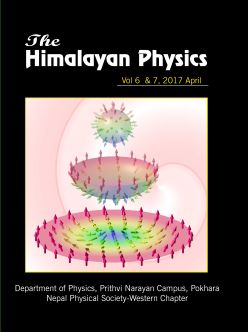Dust Structure around two Asymptotic Giant Stars at Latitude 32° & 40.67°
DOI:
https://doi.org/10.3126/hj.v6i0.18356Keywords:
Interstellar medium, Asymptotic giant branch, AGB wind, PolytropesAbstract
We studied the dust structures in 60μm and 100μm infrared image around the two asymptotic giant branch (AGB) stars. A systematic search of dust structure in the far infrared (100 μm and 60 μm) Infrared Astronomical Satellite (IRAS) survey was performed using Sky View Observatory. In order to find the possible candidate of cavity structure not yet studied, we used SIMBAD database to locate discrete sources in the region. A new relatively symmetric spherical cavity like structure (size: 1.354 pc × 0.971 pc) for candidate I and (size: 1.424 pc × 0.925pc) for candidate II at R.A.(J2000) =04h46m13.84s, Dec.(J2000) = +32°31’39.6’’ and 05h05m59.58s; +40°40’33.4’’ respectively was found at the distance of about 280 pc and 390 pc. In this present work we have calculated the dust color temperature, mass, outflow velocity, energy and size. We also studied the flux density variation and then calculated temperature and mass profile of the dust and outflow nature of AGB wind using data reduction software’s Aladin v2.5 and Aladinv8.0. Our aim was to test how outflow can be seen in this region. We have studied two cavity-like structures. The dust color temperature is found to lie in the range 21.7 K to 35.6 K for candidate I and 18.5 K to 19.3 K, with an offset of about 14 K and 0.8 K respectively. An offset of 14 K suggests that the AGB is hot in early AGB phase now in late AGB stage. We expect deviation from symmetrical outflow, i.e., AGB wind probably prefer polytropic behaviour implies bipolar type wind whereas the offset 0.8 K for candidate II suggests that the AGB is in the symmetric AGB phase, i.e., early AGB stage. The total mass of the dust in the cavity structure is found about 5.93×1025 Kg (0.00003Mʘ) for candidate I and 1.95×1027Kg (0.001 Mʘ) for candidate II. In addition we have calculated outflow energy of C-rich AGB star along ISM using outflow velocity of our candidates. It is found that the outflow velocities are 12.96 ms-1 and 10.71 ms-1 respectively. For this we have calculated the value of speed of sound (Cs) and escape velocity (uesc). In this way we have determined outflow energy, i.e., 1.173×1025J and 2.766 × 1027J respectively.
The Himalayan Physics Vol. 6 & 7, April 2017 (41-47)
Downloads
Downloads
Published
How to Cite
Issue
Section
License
This license enables reusers to distribute, remix, adapt, and build upon the material in any medium or format for noncommercial purposes only, and only so long as attribution is given to the creator. If you remix, adapt, or build upon the material, you must license the modified material under identical terms.




